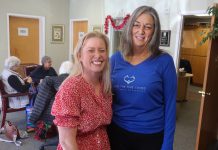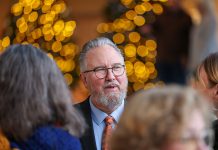Increased parcel tax described as the only way to keep
Healdsburg Hospital going
By Ray Holley, Staff Writer
No one can remember the last time Healdsburg Hospital broke
even, but its current leaders say that 2004 may be the year, if
revenues grow as projected and north county voters agree to pitch
in another $1.3 million annually.
“With the passage of the parcel tax and more revenues from the
initiatives in our Turnaround Plan, we will not need to borrow any
more funds,” said Dan Hull, Chief Financial Officer for the
hospital.
The 2004 budget for the hospital makes a series of small
assumptions in increased revenue, that add up to a big number. The
budget that Hull put together assumes that net revenue will climb
from the 2003 figure of $10.7 million to a 2004 estimate of $14.5
million, an increase of more than 26 percent.
Where will all that money – an extra $3.8 million – come
from?
Hospital leaders are predicting that patient numbers will climb
this year, and hoping that voters in Windsor, Healdsburg,
Geyserville, and Cloverdale will agree to pass a $65-perparcel
increase on the current $85-per-parcel assessment. With
approximately 21,000 parcels in the hospital district, the extra
tax would total $1,365,000 in annual revenue.
The plan amounts to an all-or-nothing scenario. Jack Air, a
member of the board of the North Sonoma County Hospital District,
the public agency that owns the hospital, puts the current
situation in perspective with the succinct comment, “There is no
Plan B, either this tax passes or we close the doors.”
The hospital has been on the brink before. A year ago, it was
within weeks of closing its doors, and almost missed a payroll.
Hull and Chief Executive Officer Dale Iversen worked with the
district board to develop a “12-Step Turnaround Plan” that they
said would keep the facility open.
The plan included a variety of ways to increase revenues. At the
time, hospital leaders were criticized for spending money on added
services and increased wages, but responded that, “one has to spend
money to make money.” The equipment and training costs were
justified as an investment in new revenue sources, and increasing
wages for nurses was seen as a way to reduce the hospital’s
reliance on costly registry nurses.
The hospital, with the assistance of the Northern Sonoma
Healthcare Foundation, outfitted a second operating room, brought
in telemetry equipment that would allow nurses to monitor heart
patients, and made plans for a sub-acute care unit that would admit
– possibly for life – severely ill or handicapped patients who
needed 24-hour-a-day care, but whose condition was stable.
Every one of the income-producing initiatives ran into one snag
or another. Equipment took longer to arrive than expected, local
staff needed extra training, and patients came in slower than
predicted. The long-awaited Emergency Room remodel has been delayed
as well, as hospital leaders ponder the best way to complete the
project.
As of this month, all three of the revenue-initiatives are in
place, and Hull said that they will gradually begin to show up in
the hospital’s bottom line. “We have calculated revenue increases
that we think are doable,” he said.
How much money does the hospital lose? The district has owned
the facility since early 2002, and accurate financial figures are
not available from Nuestro, the previous owner, so Hull has data
from nine months of 2002 and all of 2003 to work with. From April
through December of 2002, the district lost $3.6 million. In 2003,
the hospital slowed the loss rate a bit, losing $3.4 million for
the whole year.
How did the hospital cover the losses? For 2003, $1.7 million
was offset by the existing parcel tax. The other half came from the
county of Sonoma, which loaned the district $2.5 million last year.
That loan and others, which now total almost $8 million, have to be
paid back by the hospital, or, if the hospital goes under, by
taxpayers.
Hull said that $350,000 of that $2.5 million is still in the
bank, and will help keep the books balanced in 2004.
The year 2003 could have been worse. Even though the
revenue-producing initiatives were behind schedule, the hospital’s
revenues climbed, which Hull credits to the support of local
physicians. “It was the physicians, who are admitting their
patients, referring their patients, and supporting us,” he said.
“Without them, we’d never make it.”
Hull also said he was successful in negotiating better deals
with “third party payers” such as Blue Cross, Blue Shield, and
Health Net. The “Turnaround Plan” forecast a 10-percent increase in
contracts, and Hull said that every contract renewal surpassed that
goal. “For every patient that walks in we’ve negotiated an improved
payment rate,” he said.
Hull said that cost cuts were not as successful as originally
hoped for in 2003, but were significant, and will be a factor in
2004.
The hospital has also promised to increase wages. Nurses and
some other medical staff members got a raise last summer, to
compete with Santa Rosa for staffing, and Hull said that
“everybody” who did not get a raise in 2003 will get one next
summer. “In July of ’04, 51 percent of our salaries will be
increasing by 19.6 percent,” he said. “That’s huge, but that’s what
is needed to make our salaries competitive.”
Not everyone agrees that all salaries should be raised. Kurt
Hahn, a member of the district board, agreed that the job market is
quite competitive for medical personnel, but suggested that other
hospital staff might be looked at in terms of the job market. Hahn
was a minority of one at the last district board meeting, with the
other board members and senior staff insisting that all the
hospital’s employees had gone too long without raises.
The centerpiece of the hospital’s projected growth in 2004
revenue is the increase in parcel tax. North Sonoma County voters
approved an $85 per parcel per year tax in November, 2001, but
hospital leaders quickly realized that it would not be enough.
In fact, Dan Rose, a Healdsburg physician who led the “Save our
Hospital” effort, admitted that the $85 figure was based on what he
thought voters would approve, not accurate financial forecasts.
When the current hospital leaders developed the “Turnaround
Plan” last year, they forecast a $40 increase in the tax, bringing
it to $125 a year. In November, the district decided to ask the
voters for $65 more per year instead. The increase is little more
than $5 a month, but it brings the total to $150 a year, and comes
on top of recent tax assessments for school and junior college
bonds. In addition, taxpayers are looking at a possible state
bailout and a large education bond on the March ballot.
The hospital is avoiding the crowded March 2 ballot, and is
holding a special election on Tuesday, April 13. The timing of the
special election has been questioned, since property tax payments
are due on April 10 and income taxes are due on April 15, but
hospital leaders say it is the best date they could get. A campaign
committee has been formed, to take the message to voters in the
four north county communities. A telephone poll has been conducted,
but election consultant Bill Wood has declined to release the
polling results.
What if the parcel tax doesn’t pass? Hull echoes Air’s comment
about having “no Plan B” if the voters reject the tax. “The doors
would not slam shut on April 14,” said Hull. “We would be able to
have a thoughtful unwinding.”
Elected officials are watching closely. Healdsburg Hospital is
one of the largest employers in the North County, and its closure
could cause doctors to leave the area as well.
County Supervisor Paul Kelley said that he “still believes that
we need a hospital in northern Sonoma County.” A Windsor resident,
Kelley said he will vote for the tax increase, but “we have to be
serious about protecting taxpayers if it doesn’t pass.”
Healdsburg Mayor Lisa Schaffner said, “the most important thing
the hospital district can do right now is get the information out
there so that people understand what they’re being asked to vote
for.”
Windsor Mayor Debora Fudge said that the Windsor Town Council
has not yet been approached by the hospital district for support in
the upcoming special election. “I’m sure the council will be
discussing this in the near future,” she said.
Would the hospital have a future in another form, perhaps as an
urgent care center, without an emergency room? Hull points out that
the Alliance Medical Center – which is not affiliated with the
hospital – recently opened next door. “This community doesn’t need
two clinics,” he said. “Without a parcel tax, the only option is a
graceful closure.”








